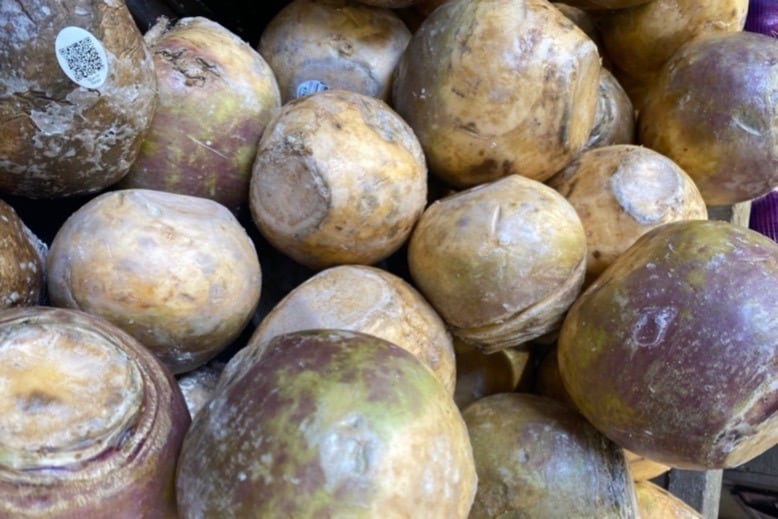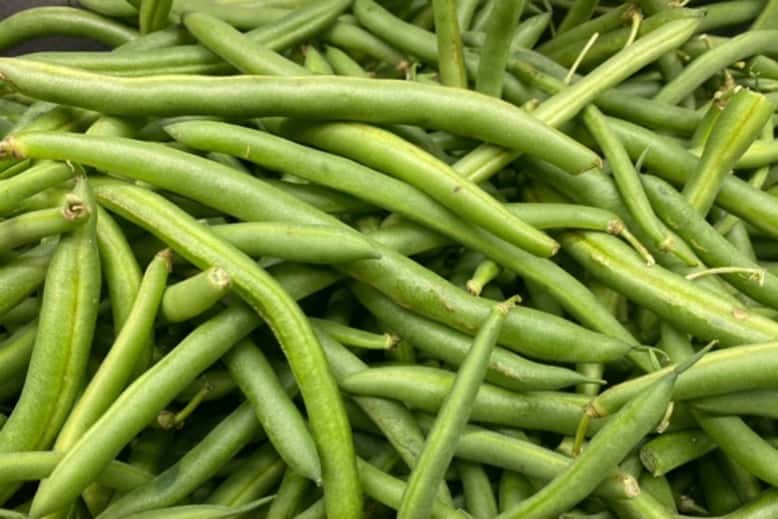
As we head into the holiday season, I wanted to highlight a couple of vegetables that will make great additions to your Thanksgiving table. One is extremely popular, while the other is truly underappreciated. Let’s start with the underdog!
RUTABAGAS
Americans consume significant quantities of almost every sort of fresh vegetable each year—except for rutabagas. And this neglected vegetable deserves better!
Rutabagas have a distinctive taste—and, if they’re prepared right, they’ll have a creamy, potato-like texture. As a result, they’ve been a must on my family’s Thanksgiving table for years, thanks to my Irish mother, Louise Morrissey. Sure, the rutabaga is a bit homely-looking, but this inexpensive, nutritious vegetable has a long shelf life and can be cooked in a number of ways. It’s generally a terrific and hearty fall/winter vegetable.

Rutabagas have a distinctive taste—and, when prepared right, a creamy, potato-like texture. Photo courtesy of Susan Bloom
Large and squat, a rutabaga looks a lot like a big, darkened white turnip with its top and tail cut off. The skin is purple at the top and yellowish below, and the whole root is heavily waxed to prevent it from losing moisture and shriveling. In season from October through early summer, rutabagas are grown in cooler climates everywhere—but for the U.S. market, Canada grows the best ones.
SELECTION & STORAGE OF RUTABAGAS
Choose rutabagas that are heavy in the hand for their size, more rounded than pointed, and hard as a rock with no soft spots. The tops should be purple and bright-looking, and the wax should have a good shine to it. You can tell right away if a rutabaga is old—the wax will look dull, and the rutabaga will feel light. If you can, store rutabagas in a cool, dark place like a root cellar; however, even if they’re stored at normal room temperature, rutabagas in good condition will keep for a couple of months.
PREPARATION OF RUTABAGAS
Prepare rutabagas as you would potatoes or acorn squash. In our house, we peel, cube and boil them, then mash with butter, salt and pepper. For a milder rutabaga flavor, you can also mix in potatoes. Personally, I love mashed rutabagas on their own—they’ve got a distinctive taste, and they really stick to your ribs. They also make excellent side dishes to turkey, roast chicken, pork roast, pork chops or ham.
STRING BEANS

Late fall and early winter are the best times to get the sweetest, most velvety green beans. Photo courtesy of Susan Boom
String beans are so named because years ago they contained a string—a tough fiber that ran from one tip to the other. While the string has since been bred out of most varieties you’ll see on the market, the name has stuck. Although there are several varieties, they’re generally divided into two categories: bush beans, which have a rounded pod, and pole beans, which are usually large and relatively flat.
One of the best pole beans is the Kentucky Wonder—a bright green, fairly broad bean that grows 6–8 inches in length. When fresh, young and velvety, Kentucky Wonders have a sweet taste and an excellent, crisp texture.
But a definite virtue of pole beans is that they’re usually picked by hand. Although hand-picked beans tend to be more expensive, they may be a better buy in the long run because they result in less waste. Machine-picked beans are usually a less tender variety because they have to be tough to survive the machine-picking process. Farm workers picking beans by hand are also a bit more selective than machines.
While fresh string beans are available year-round, they’re best in early fall, early winter and early summer. Beans picked early in the season are smaller, sweeter and more velvety. Beware of long, thick or bumpy pods that show the outline of the beans inside; these are too mature and will be tough and tasteless.
SELECTION & STORAGE OF STRING BEANS
Look for small- to medium-sized pods that are bright green and velvety-looking, with no signs of wilting or wrinkling. Fresh string beans should be tender enough to eat raw. The USDA classifies string beans as snap beans, and that’s exactly what the bean should do when you bend it—snap. If it’s rubbery and bends instead of snapping, it will taste rubbery, too.
Don’t wash string beans until you’re ready to use them. Refrigerate them in a paper or unsealed plastic bag; they’ll keep well for a day or two, although it’s best to use them as soon as possible. If you’ve had them longer than a day or two and they’re starting to wilt, you may be able to revive them in ice-cold water; otherwise, add them to soups or stews.
PREPARATION OF STRING BEANS
Tender, young string beans can be added raw to crudités. You can also steam them, or cook in a small amount of water in a covered pan for 5–8 minutes, adding a dab of butter and some salt and pepper, if desired. Just make sure not to overcook them! String beans also freeze well if they’re blanched for two minutes beforehand.
STRING BEANS VS. HARICOTS VERTS
When you’re in the supermarket in pursuit of string beans, you’re often presented with two options: green beans and—usually right next to them—haricots verts, which are sometimes called French green beans. I’m often asked what the difference is between the two. The answer? Not very much! In fact, haricots verts translates to “green beans” in French. But haricots verts tend to be younger, skinnier, more tender and more flavorful than comparably sized traditional green beans; they’re bred that way. They’re also more expensive. In France, the skinnier, pricier ones are called haricots verts filets extra-fin.
BETTE’S BEST STRING BEAN SAUTÉ
I hope you’ll make time to eat your veggies this Thanksgiving—especially my wife Bette’s delicious string bean recipe, which our family looks forward to every year. Wishing you and yours a great holiday!
- 1 pound fresh green beans or French string beans
- 2 tablespoons extra virgin olive oil
- 2 tablespoons butter
- 2 garlic cloves, chopped
- ¼ cup flavored bread crumbs
- 3 tablespoons Parmesan cheese
- Salt and pepper (to taste)
Wash and trim string beans. Add them to a pot of boiling water, and cook until al dente. Drain water. In a large frying pan, heat olive oil and butter over medium heat. Add garlic, sautéing until it’s a light golden-brown color (be careful not to burn it!). Add string beans, stirring until they’re evenly coated. Sprinkle string beans with bread crumbs and stir. Serve on a platter and enjoy!
About “Produce Pete” Napolitano
With over 65 years of experience in the produce industry, New Jersey’s own “Produce Pete” Napolitano is a renowned fruit and vegetable expert, author, and TV personality who’s appeared on a highly popular segment on NBC’s Weekend Today in New York, broadcast every Saturday morning for over 28 years. For more information, visit producepete.com.
About Susan Bloom
A regular contributor to New Jersey Monthly and a variety of other well-known local and national publications, Susan Bloom is an award-winning New Jersey–based freelance writer who covers topics ranging from health and lifestyle to business, food and more. She’s collaborated with Produce Pete on a broad range of articles for over a decade.
